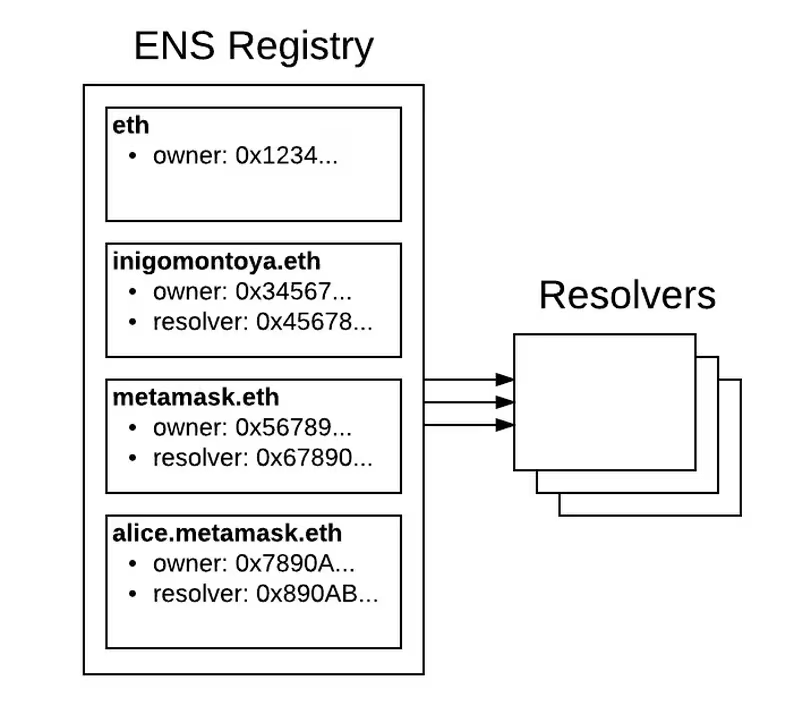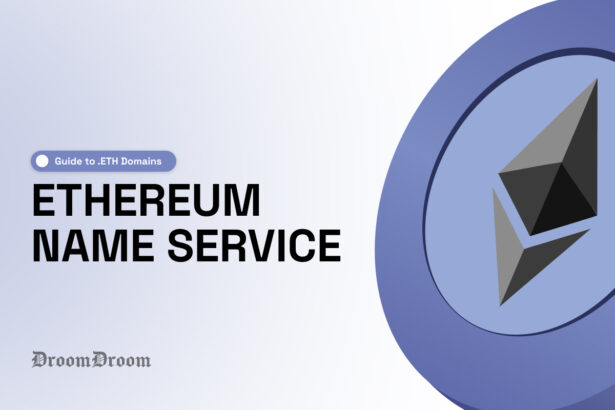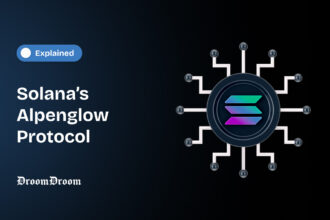Remember the early days of the internet? Users were required to type out long and complex IP addresses to reach websites. So cumbersome and prone to errors! That’s the problem Domain Name System (DNS) resolved. It translates numeric IP addresses into user-friendly domain names like “droomdroom.com.”
- What Is Ethereum Name Service (ENS)?
- Technical Architecture of Ethereum Name Service (ENS)
- Understanding .ETH Domains
- 4 Practical Applications of ENS
- 1. Simplified Wallet Addresses
- 2. Decentralized Websites
- 3. Web3 Identities
- 4. Integration with dApps and Services
- How to Register and Manage an ENS Domain
- Step 1: Setting Up a Crypto Wallet
- Step 2: Visiting the ENS App
- Step 3: Registering Your .ETH Domain
- Step 4: Setting Up Resolvers and Records
- Step 5: Renewing Your ENS Domain
- Conclusion
Fast forward to today blockchain technology faces a similar challenge. Ethereum users must input long hexadecimal wallet addresses to send funds or interact with smart contracts.
Blockchain addresses are even more cryptic than IP addresses often consisting of strings like “0xd8dA6BF26964aF9D7eEd9e03E53415D37aA96045.” These addresses are not only hard to remember but also susceptible to costly errors—one wrong letter or number and the transaction is lost forever. This is where the Ethereum Name Service (ENS) comes into play.
ENS is designed to make blockchain addressing simpler. Just as DNS maps IP addresses to domain names, ENS translates complicated Ethereum addresses into readable and memorable names, such as “vitalik.eth.”
What Is Ethereum Name Service (ENS)?
ENS or Ethereum Name Service is a decentralized naming protocol built on the Ethereum blockchain. At its core, it maps machine-readable identifiers—such as Ethereum wallet addresses or IPFS content hashes—to human-readable names like “alice.eth.”
By doing so, ENS makes it easier for users to interact with blockchain resources. Of course, instead of pasting long complex Ethereum addresses users can input simple ENS names.
Unlike traditional DNS, ENS is not confined to centralized servers. It operates entirely on smart contracts which give users more control over their domains while providing improved security and censorship resistance.
Let me tell you that ENS is also extensible. It supports not just Ethereum addresses but other types of data such as social media profiles or decentralized websites.
Technical Architecture of Ethereum Name Service (ENS)
The ENS architecture is built on two primary components named the registry and the resolvers.
1. Registry
The ENS registry is a smart contract that keeps track of all domain names and subdomains. Your crucial information is stored here! Such as the domain owner, the resolver responsible for that domain and the caching time-to-live (TTL) for records.

You should know that the registry is the backbone of the ENS system as it maps names to the appropriate resolvers.
2. Resolvers
A resolver is another smart contract responsible for translating names into the respective Ethereum addresses or other blockchain data. When a user queries a name like “bob.eth” the resolver checks the registry for the corresponding address and returns the information.
3. Namehash Algorithm
When registering a .ETH domain the ENS system utilizes an algorithm called namehash to process and store domain names securely on the Ethereum blockchain. The namehash algorithm is important because it ensures compatibility between human-readable names and the cryptographic requirements of Ethereum’s architecture.
This amazingly powerful architecture makes sure that all domain resolutions are handled securely and transparently on the Ethereum blockchain. The hierarchical nature of Ethereum Name Service domains means that domain owners can create and manage their own subdomains.
Understanding .ETH Domains
While we are discussing Ethereum Name Service we should also discuss one of its most prominent features is the .ETH domain. These domains act similarly to traditional internet domain names but with a focus on the decentralized, blockchain-driven world.
A .ETH domain is a top-level domain (TLD) native to the Ethereum Name Service and is particularly popular for creating human-readable names linked to Ethereum wallet addresses.
Why Are .ETH Domains Unique?
Well the main reason that makes .ETH domains unique is their integration with the Ethereum blockchain.
So unlike traditional domains governed by centralized organizations such as ICANN (Internet Corporation for Assigned Names and Numbers) .ETH domains are controlled entirely by the owner through smart contracts on the blockchain.
Basically it means that you as a user have full ownership of your domains without relying on third-party registrars. Domains can be transferred, subdomains can be created and ownership can be proven—all securely and transparently on the blockchain.
For example, the owner of “mywebsite.eth” can set up “shop.mywebsite.eth” or “email.mywebsite.eth” with full control over each subdomain.
Another very cool reason is that .ETH domains are effectively non-fungible tokens (NFTs), built on the ERC-721 standard. So of course they are tradable and just like any other NFT you can transfer or sell a .ETH domain on an NFT marketplace such as OpenSea.
4 Practical Applications of ENS
Ethereum Name Service surely extends far beyond simple wallet address translations. Here are some of the most compelling use cases for ENS so let’s explore shall we?
1. Simplified Wallet Addresses
We have already discussed this far and beyond already. Instead of copy-pasting long addresses you can share your .ETH domain. It undoubtedly reduces the likelihood of errors in transactions.
Also, you can map your .ETH domain to multiple types of addresses. Confused? For example, alice.eth could be set up to receive both Ethereum and Bitcoin payments which ultimately makes it a universal identifier in the decentralized financial space.
2. Decentralized Websites
ENS also powers decentralized websites. It extends Web3’s decentralized ethos to content hosting.
Using IPFS (InterPlanetary File System) or other decentralized storage networks like Arweave or Swarm you can host content that is censorship-resistant and fully decentralized. Yes, it is happening!
For instance, you might map blog.alice.eth to a blog hosted on IPFS. It allows users to access decentralized content through Web3-enabled browsers like Brave or MetaMask.
One more thing is that these decentralized websites are not limited to the Ethereum ecosystem. Let me support this with the recent development in this! In February 2024, GoDaddy announced that it would enable users to link their GoDaddy DNS domains with ENS names for free. So it ultimately means that decentralized content can be accessed via both the DNS and ENS systems.
3. Web3 Identities
Users can link their .ETH domain to not just wallet addresses but also metadata such as email addresses, social media profiles and other personal details. This creates a single unified Web3 identity that can be used across multiple dApps.

You can maintain consistency across the Web3 ecosystem by connecting metadata to their .ETH domains. You can have your ENS domain automatically link to their social media profiles or email. It allows services to retrieve this data from the blockchain without users having to re-enter it every time they interact with a new dApp.
4. Integration with dApps and Services
Popular platforms like Uniswap, OpenSea and Aave allow users to connect their ENS names directly to their accounts so users can simply input their .ETH domain to to interact with these platforms.
Also services such as ETHMail and Skiff Mail enable users to send and receive emails using their ENS domains. This extends the practical utility of ENS beyond financial transactions. In these cases ENS becomes a cross-platform identity provider for users to interact with decentralized and traditional services alike.
How to Register and Manage an ENS Domain
Here’s a step-by-step guide on how to register and manage your ENS domain.
Step 1: Setting Up a Crypto Wallet
To get started with ENS you’ll need an Ethereum wallet that supports dApps. Popular choices include MetaMask, Coinbase Wallet and Trust Wallet.
Then you’ll need sufficient Ether (ETH) for domain registration and gas fees.
Step 2: Visiting the ENS App
Once your wallet is ready visit the official ENS app at app.ens.domains. Here, you can search for available .ETH domains by typing your desired name into the search bar. If the name is already taken of course then the system will display the owner and expiration date.
Step 3: Registering Your .ETH Domain
If the name is available you’ll be able to proceed with registration. The ENS system will prompt you to choose the registration period. Interestingly enough, the cost of registration depends on the length of the name—
- Domains with 5 characters or more cost approximately $5 per year.
- Domains with 4 characters cost around $160 per year.
- 3-character domains cost about $640 per year.
Keep in mind, these fees do not include the gas fees needed to process the transaction on the Ethereum network.
Once you’ve selected your desired registration period you’ll need to confirm two transactions from your wallet. The first transaction initiates the registration process and the second completes it after a brief waiting period. This is obviously done to not let multiple people from attempting to register the same domain at once.
Step 4: Setting Up Resolvers and Records
After successfully registering your .ETH domain, the next step is to set up a resolver.
To set up the resolver go to the ENS Manager interface and navigate to the “My Domains” section. Here you can link your domain to your wallet address and manage other records associated with your ENS domain. You can also set up subdomains and assign different addresses or data to these subdomains as needed.
Step 5: Renewing Your ENS Domain
ENS domains operate on a rental basis which means that you will need to renew your registration periodically. If a domain expires, anyone else can claim it through the same registration process hey listen up keep track of your renewal dates.
Conclusion
The Ethereum Name Service (ENS) is an extremely wonderful game-changer in the Web3 space. It definitely is an innovation that stays true to its motive which is to simplify interactions on the blockchain by providing human-readable names that link to Ethereum addresses and other decentralized resources.
By combining the security of the Ethereum blockchain with the user-friendliness of the DNS model, ENS makes blockchain technology more accessible for everyone—from crypto enthusiasts to mainstream internet users.



















